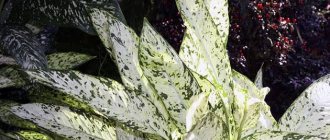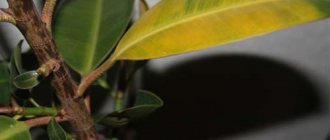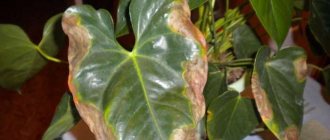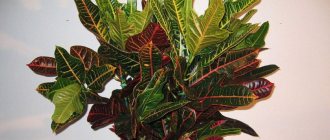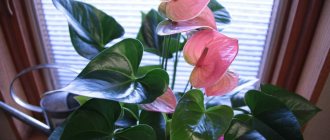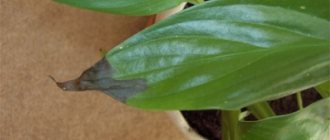A characteristic feature of begonia is its varied color range. An amazingly beautiful flower is considered indoors, but under certain conditions it grows outdoors. Like any ornamental plant, it requires careful care and attention. Often, for no apparent reason, begonia leaves begin to curl and dry out.
There are several explanations for this:
- improper care, non-compliance with watering conditions;
- inappropriate temperature;
- lack or excess of fertilizers;
- illness;
- pests
The plant is unpretentious, but for full growth and active flowering it requires a special approach and attention.
Care: soil, watering, temperature conditions
When begonia leaves dry, it is necessary to determine the cause, choose methods, means and methods of elimination.
- Selection of capacity. Pots should be chosen low but spacious; there should be enough space for the root system. Preference is given to ceramic containers: they allow air to pass through. Before use, they are soaked in water for several hours. If the container has already been used, be sure to thoroughly rinse, disinfect and dry it.
- Temperature changes. Reacts sharply to sudden changes in temperature and does not like drafts. This can happen when you turn on the air conditioner, heater, or move the pot from a warm room to a loggia or balcony. When the first signs of wilting appear, it is worth returning it to its previous “place of residence” and monitoring the room temperature. From October to January, when they are at rest, they are moved to a cooler place, but the air temperature should not be lower than 12 degrees.
- Watering. It is recommended to use settled or filtered warm water; under no circumstances should you water with cold tap water. Add a small amount of lemon juice or citric acid to it. Watering is carried out twice a week in hot weather and once in winter. It is advisable to carry out the procedure at the same time. Ensure good drainage so that water does not stagnate. Over-wetting the soil is unacceptable.
- Priming. The soil mixture is purchased in specialized stores or prepared independently from peat, compost, sand, and leaf soil. The main requirement is that the soil should not have a high level of acidity.
Advice! What to do if the leaves of a begonia dry when grown outdoors? In dry weather, spray them with water 2-3 times a week, build a shelter from direct sunlight.
The problem may be dry indoor air. In such cases, place containers with water and carry out regular spraying. Or they place the pots on trays with sand and pebbles, which are periodically moistened.
Interesting Facts
- Begonia tubers can be eaten and have a citrusy flavor.
- This flower is a state symbol in North Korea - it can even be seen on the flag of this country.
- The seeds of the plant break all world records in size. From a bag weighing 30 grams, you can get about 3,000,000 sprouts.
- In ancient times, Begonias were used to polish sword blades.
- One of the main beneficial properties of the flower is the ability to purify the air and increase immunity. Therefore, Begonia is often placed in rooms where there are children. especially allergy sufferers.
We wrote everything about whether it is possible to keep begonia in the house, and read about the beneficial and harmful properties of this plant for the home and people here.
I hope that after reading this article you are finally convinced that the plant described is ideal for novice gardeners and busy people. After all, caring for the Imperial Flower does not take much time and is not difficult. So, go for it!
If you find an error, please select a piece of text and press Ctrl+Enter.
Begonia is a beautiful flower that delights lovers with a riot of colors. This plant has many types and is grown both in an apartment, as an indoor plant, and in the garden. Few people know that begonia is called elephant or bear ear due to the amazing shape of its leaves. Like any plant, begonia requires attention, care, love and proper care. Often flower growers cannot solve the problems that arise during the process of growing a flower themselves. The bush is capricious, withers, does not want to grow, the leaves curl, dry along the edges and fall off, the flowers turn black. Let's try to figure out why this happens.
Top dressing
Begonia leaves curl and dry when grown on depleted soils and lack of mineral and organic fertilizers. Feeding is carried out twice a month, from March to September. It is necessary to follow some feeding rules:
- spend only in the evenings;
- before fertilizing, moisten the soil 2-3 hours before the procedure;
- strictly follow the instructions: oversaturation will lead to oppression and death of the flower;
- Do not allow solutions to come into contact with leaf plates.
Preference should be given to complex fertilizers, which are recommended to be purchased in specialized stores. Consult with professionals, study the method of use and dosage. Experienced flower growers prefer to use proven and reliable preparations.
- "Begonia". Saturates with phosphorus, potassium, microelements.
- "Bona Forte". A broad-spectrum drug. Provides protection from harmful environmental influences and helps fight stress. Saturates with nitrogen, humic acid, phosphorus, and other useful substances.
- "Good Power" It is an excellent growth stimulator, a source of succinic acid, vitamins, and microelements. Stabilizes and accelerates flowering and bud formation. Used as a prophylactic against diseases.
Reference! Ammonium nitrate has a beneficial effect in small quantities.
To understand why the leaves of indoor begonia dry out, you should make sure that it receives a sufficient amount of the necessary fertilizers. Active growth and flowering is ensured if the basic feeding requirements are met.
What kind of plant is this?
A plant first found on the island of Haiti and named after the governor of this island, Michel Begon (it also has other names - Emerald, Imperial). The entire family includes over one and a half thousand varieties. There are annual and perennial varieties.
They develop to the size of shrubs and subshrubs. Usually the leaf plates of this flower have an asymmetrical original shape. Their shade is always very rich, and the pattern formed by the veins creates a unique effect. There are no peculiarities in the growth of Begonia.
On a note. Begonia is very easy to care for. And if you follow all the recommendations, you practically don’t get sick.
But, unfortunately, everything is not always rosy. Begonia leaves can be attacked by diseases and pests and begin to dry out, or even fall off altogether.
Pests
When asking the question: “Why do begonia leaves dry at the edges?”, you should carefully examine it for presence or damage by pests.
- Greenhouse aphid. If measures are not taken, the plant will die in a short time; pests multiply at lightning speed, sucking out the juice. The drugs “Fufanon” and “Aktellik” are used for control. Spray with a solution of laundry soap.
- The false shield is soft. Settling inside the shoots, it stops growth. The appearance of this pest may serve as an answer to the question: “Why do begonia flowers and leaves dry out?” Clean them manually with a soft brush and spray with garlic infusion.
- Greenhouse whitefly. When affected, the plants dry out, first changing color. When the first symptoms appear, it is necessary to completely get rid of the problem in a short time. A soap solution helps fight (add 10 g of liquid soap to 2.5 liters of water). Do not allow excess product to get under the roots.
It is important to make sure that you do not introduce pests with the soil you prepared yourself. Therefore, when using a homemade soil mixture, it must be treated using insecticides and heat treated.
Reference! To disinfect the soil, it is calcined in the oven and treated with a solution of potassium permanganate.
If the Emerald Flower has completely dried up, how to revive it?
It happens that not one or even several leaves dry out, but all at once. Don’t rush to say goodbye to your plant right away. Perhaps only the ground part of the flower has deteriorated, but the rhizomes remain alive.
- Remove the flower from the pot and inspect the roots for rot and parasites. If most of them are in good condition, remove the damaged ones and plant the remaining ones in new soil.
- Get rid of any dead leaves, buds and stems, feed the soil, and then cover the pot with a plastic bag or film.
- The main thing is to place the flowerpot in a suitable place - take into account the air temperature and lighting.
- Spray with Epin every seven days.
If, when studying the roots, not a single living thing was found there, then, unfortunately, the flower cannot be saved.
Recommendation. If possible, get rid of this soil, because pests can live there, which is why the plant died. It is better to pay and buy a new soil mixture than to destroy a young plant every time.
Diseases
The flower is affected by a disease - this is why begonia leaves dry at the edges and subsequently fall off. Such troubles happen for several reasons that need to be clarified and eliminated as soon as possible.
- Downy mildew. The first sign is a whitish coating. After a short time, the tips of the leaves dry out and crumble. In the early stages, the fungicides “Fundazol” and “Moristan” are effective. For preventive purposes, spray with a solution of copper sulfate and laundry soap.
- Bacterial spotting. The plant becomes covered with brown watery spots, the inflorescences turn black. The soil is disinfected with special chemicals. For prevention, treat with copper oxychloride.
- Gray rot. Fungal infection is identified by a characteristic fluffy gray coating. Gradually the entire plant dies. It is treated with tincture of ash and potassium permanganate, treated with fungicides “Topaz”, “Fundazol”, “Topsin-M” when the first symptoms appear.
Advice! When the first signs of disease appear, it is necessary to take emergency measures and treat the plant and soil with special preparations.
When begonia leaves curl and dry outside, the cause may be: insufficient watering, heavy rainfall, sunburn, accumulation of dust and dirt. This also happens in the case of dense plantings: the distance between bushes should not be less than 50 cm.
Features of the manifestation of the problem
Begonia is a tropical plant. If the growing conditions (watering, temperature, air humidity) are not observed, the plant’s color may change to yellow and dry leaves may appear.
Flower growers should pay attention if:
- the leaves turned yellow;
- pigmentation appeared in the form of yellow spots;
- the edges have become brittle, with a dry brown edging;
- plant growth has slowed down;
- general condition is sluggish, lifeless.
The presence of one or more signs indicates a violation of the rules of plant care, bacterial damage or the presence of pests. This is a signal to move the begonia separately from healthy plants and carry out a thorough inspection.
Prevention
In order not to look for the reasons why begonia leaves dry at the edges, it is necessary to periodically adhere to the basic principles and carry out preventive treatments.
- Carefully select the soil and treat it before planting.
- Avoid stagnation of water when watering.
- Loosen the soil regularly.
- Provide comprehensive fertilizing throughout the entire growing season.
- Promptly remove damaged and diseased leaves and inflorescences.
- Do not place pots near radiators, stoves, air conditioners and heaters.
- Maintain the air temperature within 12 - 20 degrees.
- When planting, place the tubers in containers shallowly so that the apical buds are visible, and add soil as they grow and take root.
Reference! Begonia does not tolerate moving from place to place; the plant tolerates stress.
The effective remedies “Epin” and “Zircon” are used as a growth stimulant and as a stress reliever. When transferring from a smaller pot to a larger one, you must carefully handle the root system. Damage to the roots will soon lead to disease and possibly death. Only timely measures taken will avoid irreversible consequences.
Begonia withers and dries - what to do, preventive measures when the cause is not clear
Why balsam does not bloom at home - the main reasons
If a begonia suddenly begins to wither before our eyes for no apparent reason, it is worth reconsidering the conditions of its maintenance and the presence of parasitic insects. Among them, thrips stand out for their large size - they are easy to spot even without a magnifying glass. They cause significant harm to begonias - the leaves turn pale, the buds do not bloom, and the flower itself does not grow. You should be wary of these pests in the summer; they are destroyed with a soap solution.
wilting plant
If the begonia has grown too much, it needs to be transplanted into a larger pot. In this case, you need to pay attention to the roots of the plant - blackening and rot indicate disease. It is called “Black Root Rot”, the remedy for it is spraying with Benomyl. To avoid relapse, you need to water the plant moderately, avoiding excess moisture. Until the top layer of soil has dried, there is no need to moisten the begonia.
Even in hot summers, the temperature in the room where this flower is kept should not exceed 21-23 degrees. If the plant is very hot, its leaves will begin to turn yellow and red, and under the scorching sun, burns will appear. To avoid this, it is better to keep begonia in partial shade, periodically placing it in a bright place.
Any indoor plants should be kept away from drafts, sources of heat and cold. Any of these factors will cause the begonia's foliage to deteriorate, and it may even stop blooming. During the flowering period, it needs fertilizing and regular watering!
Healthy begonia
Begonia is a decorative indoor plant that attracts attention with its delicate buds and bright spreading foliage. It is not difficult to maintain, but the requirements for air humidity, soil and watering are important to comply with for its beautiful appearance. Preventive care measures will help prevent the occurrence of diseases and eliminate the problem of why begonia withers.

